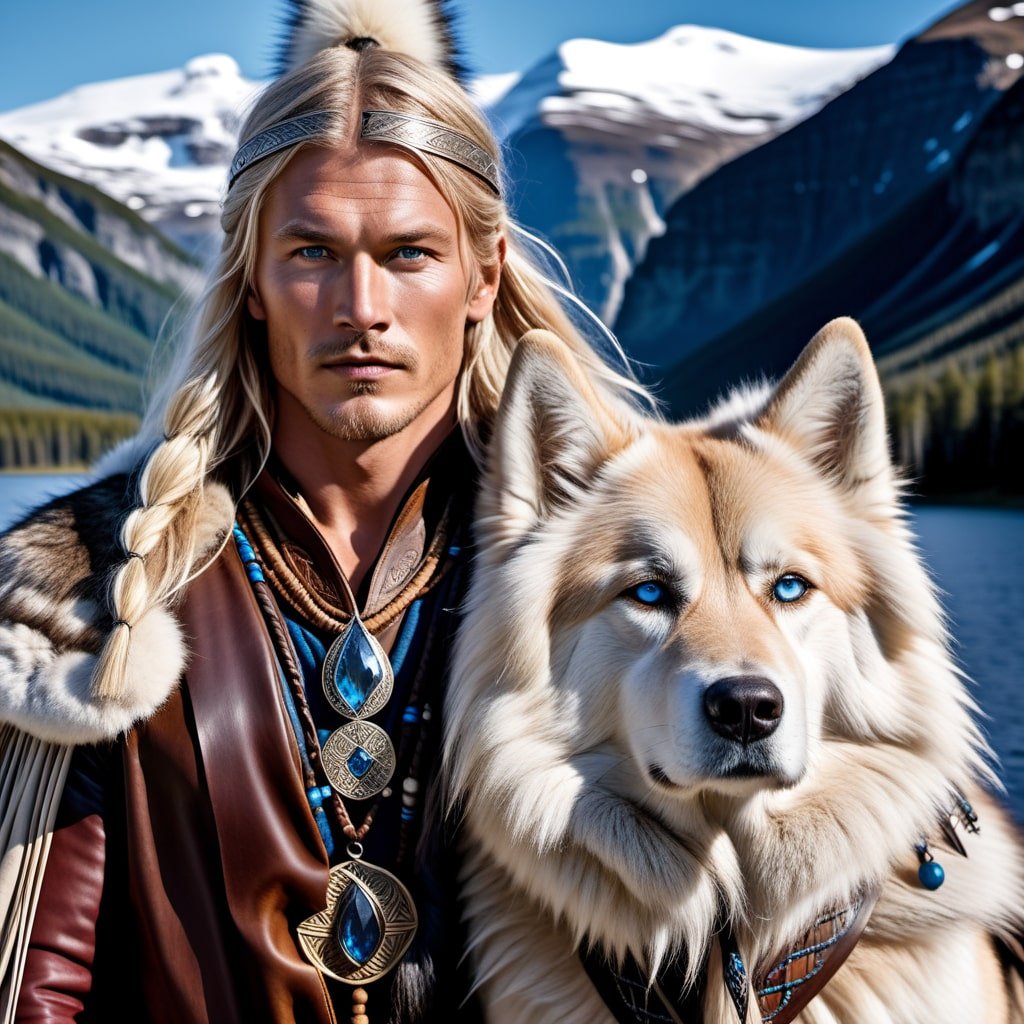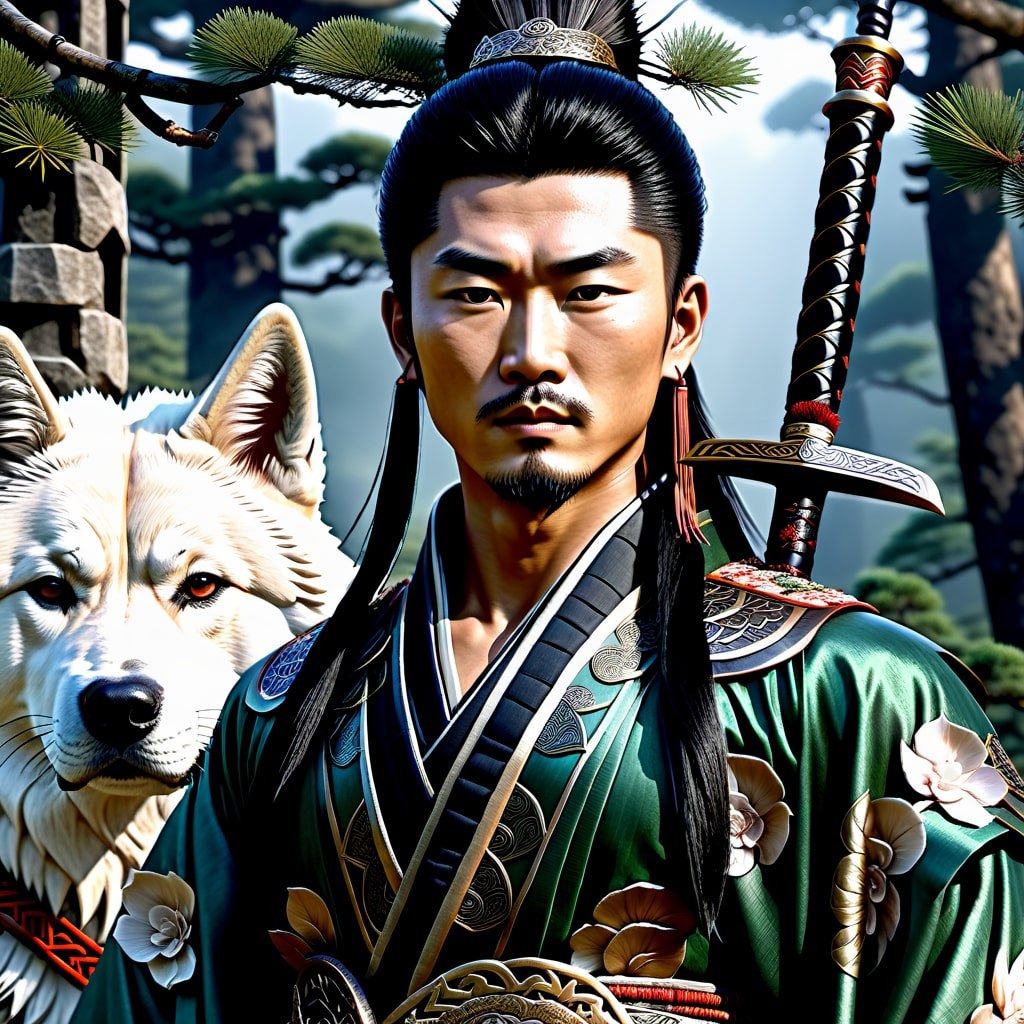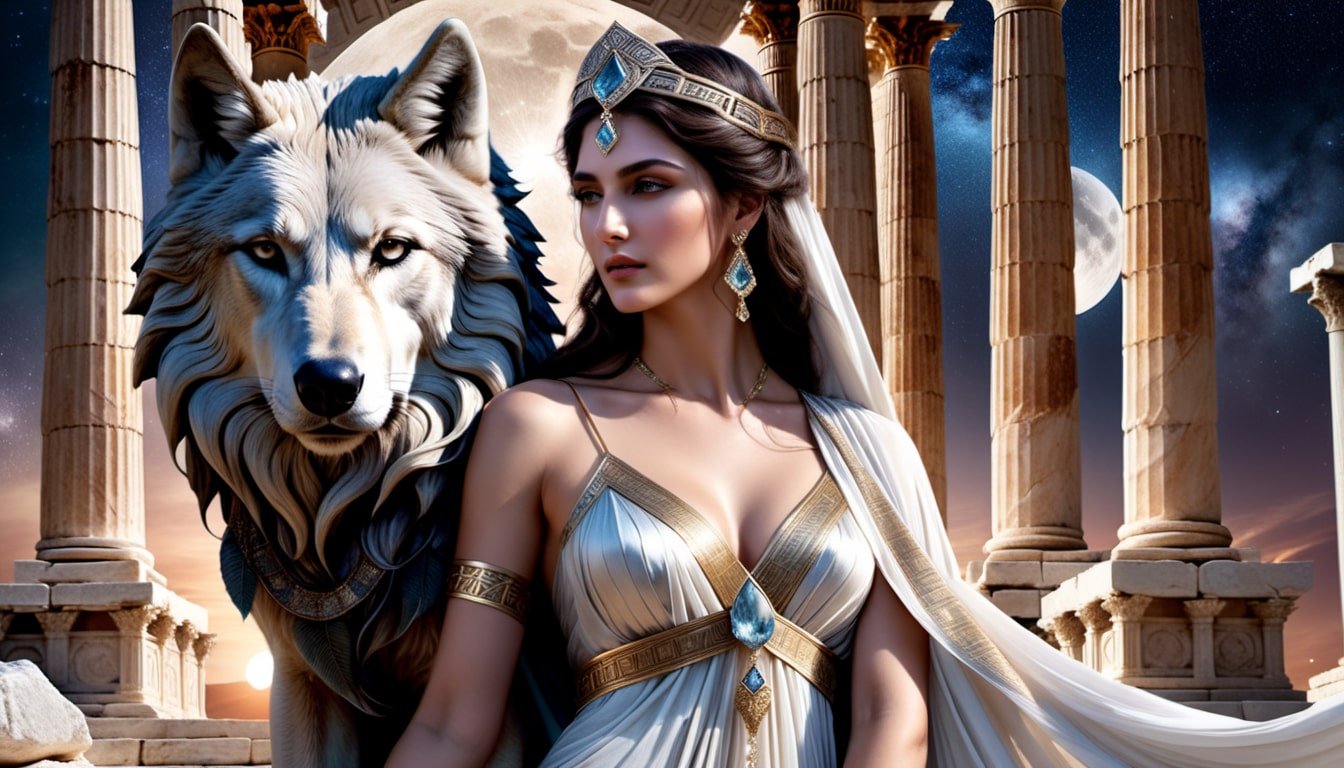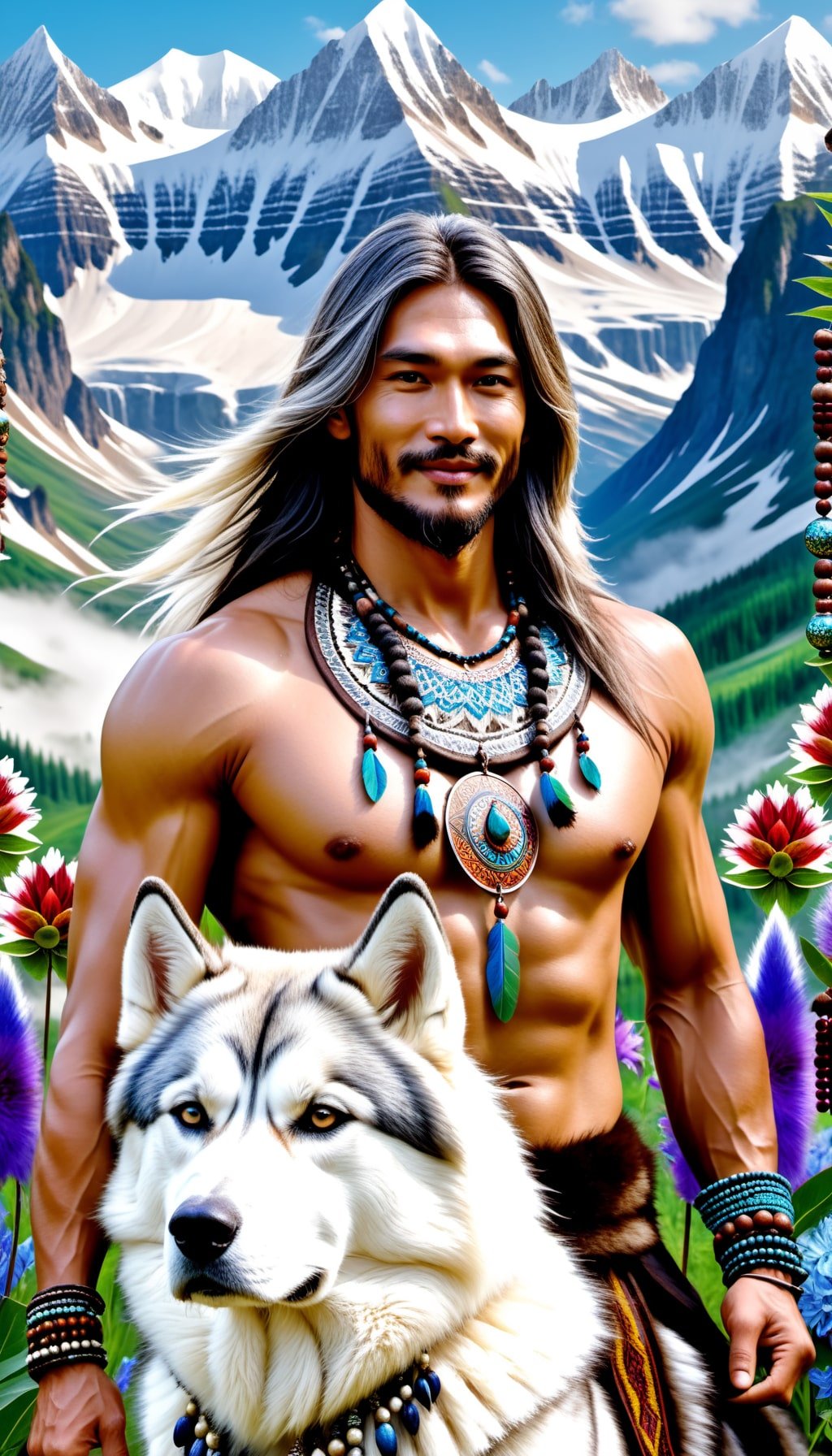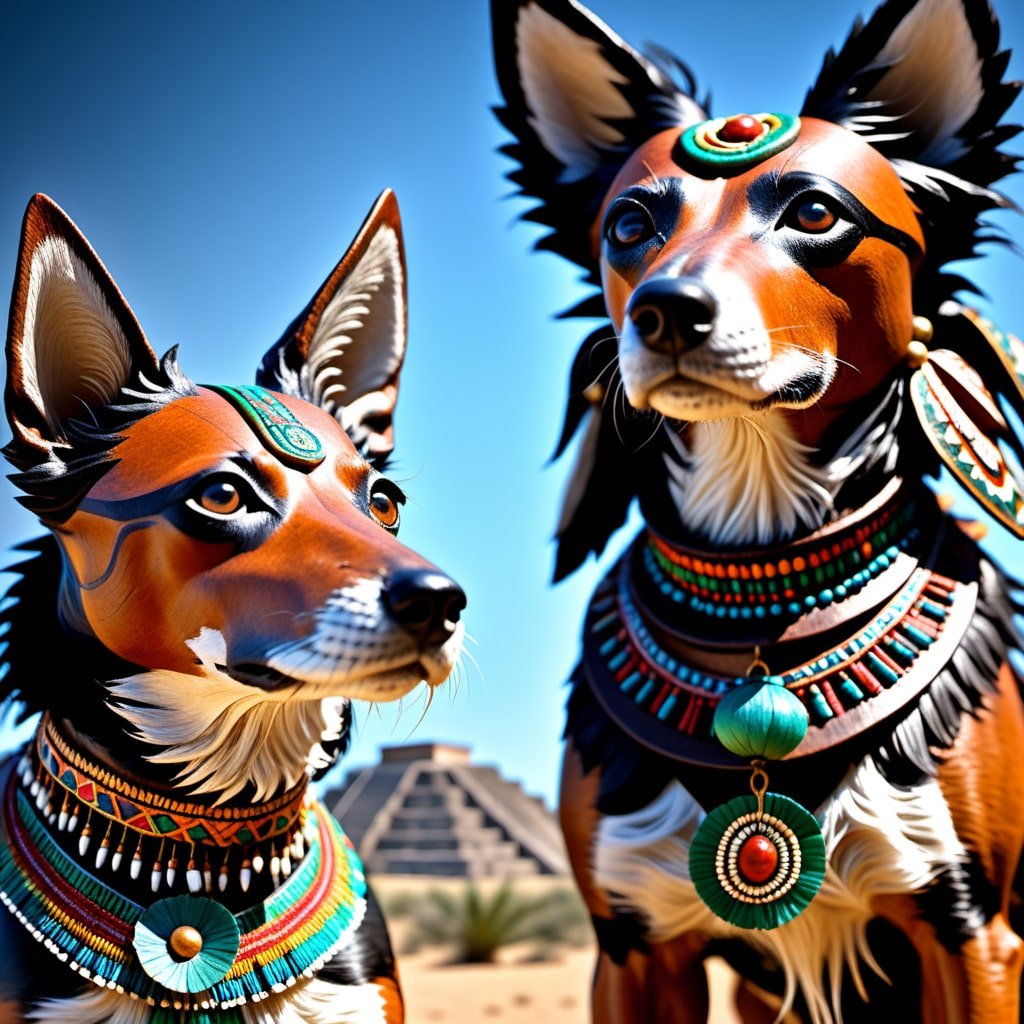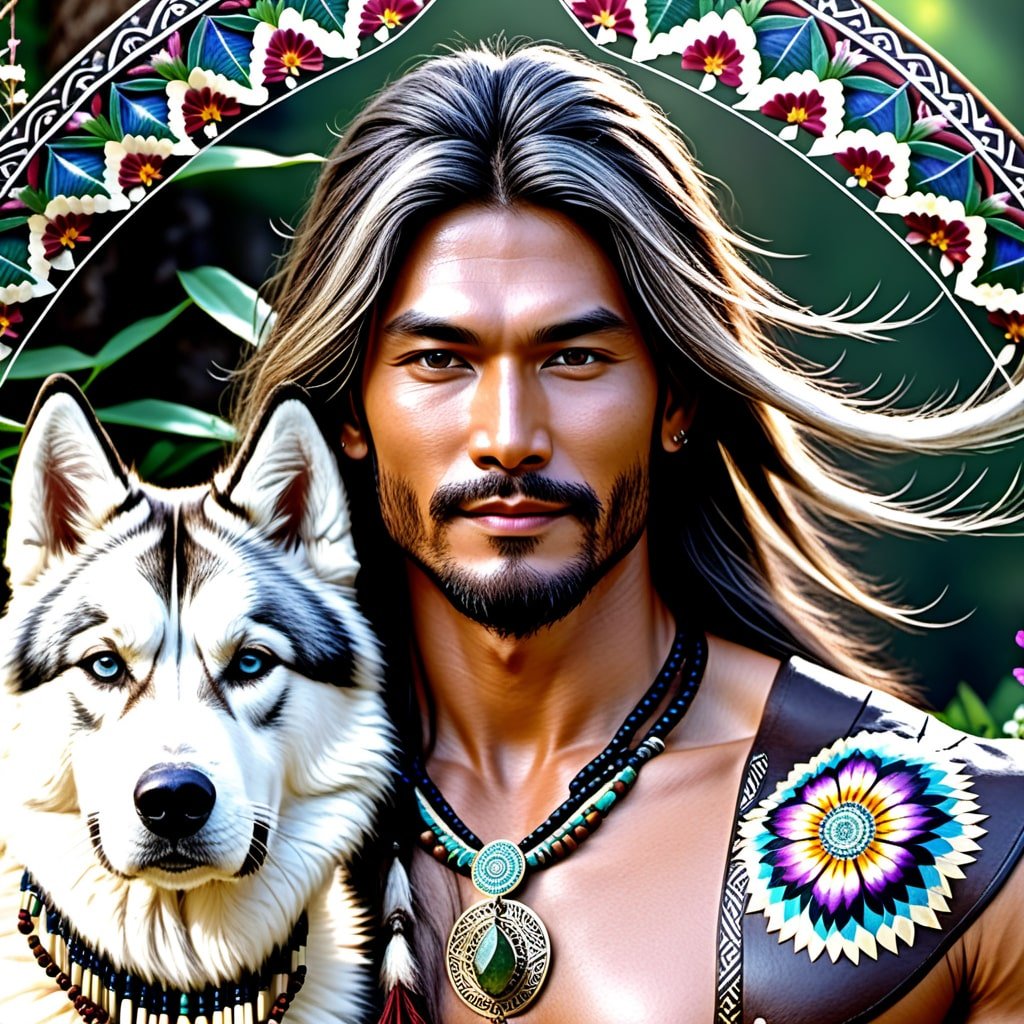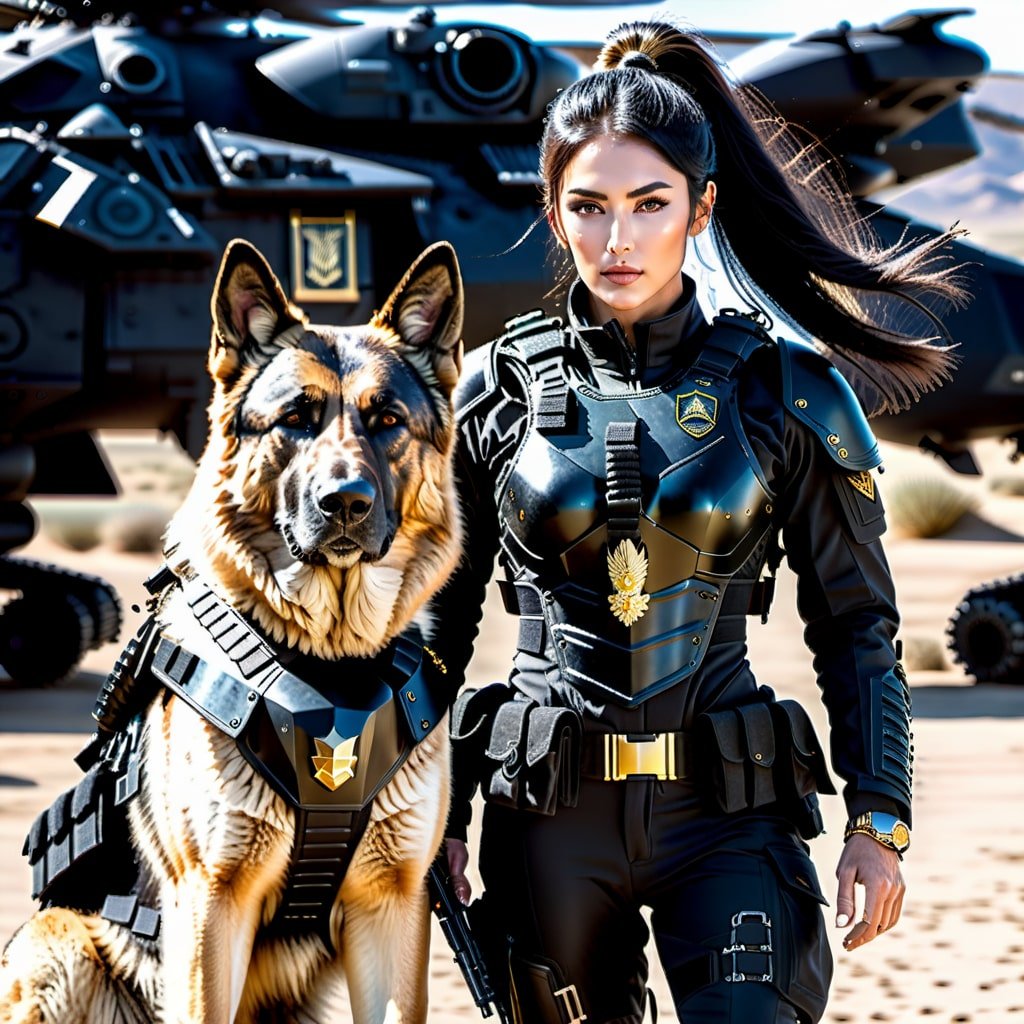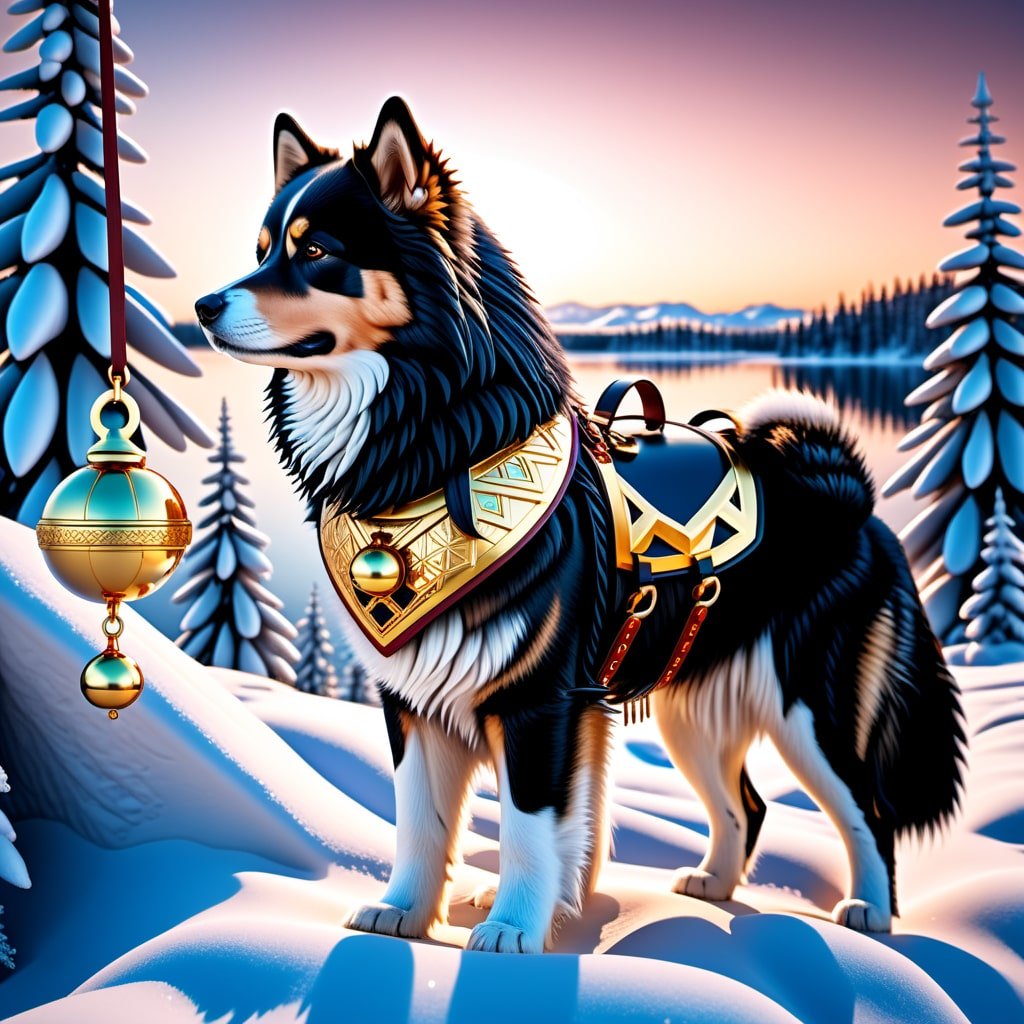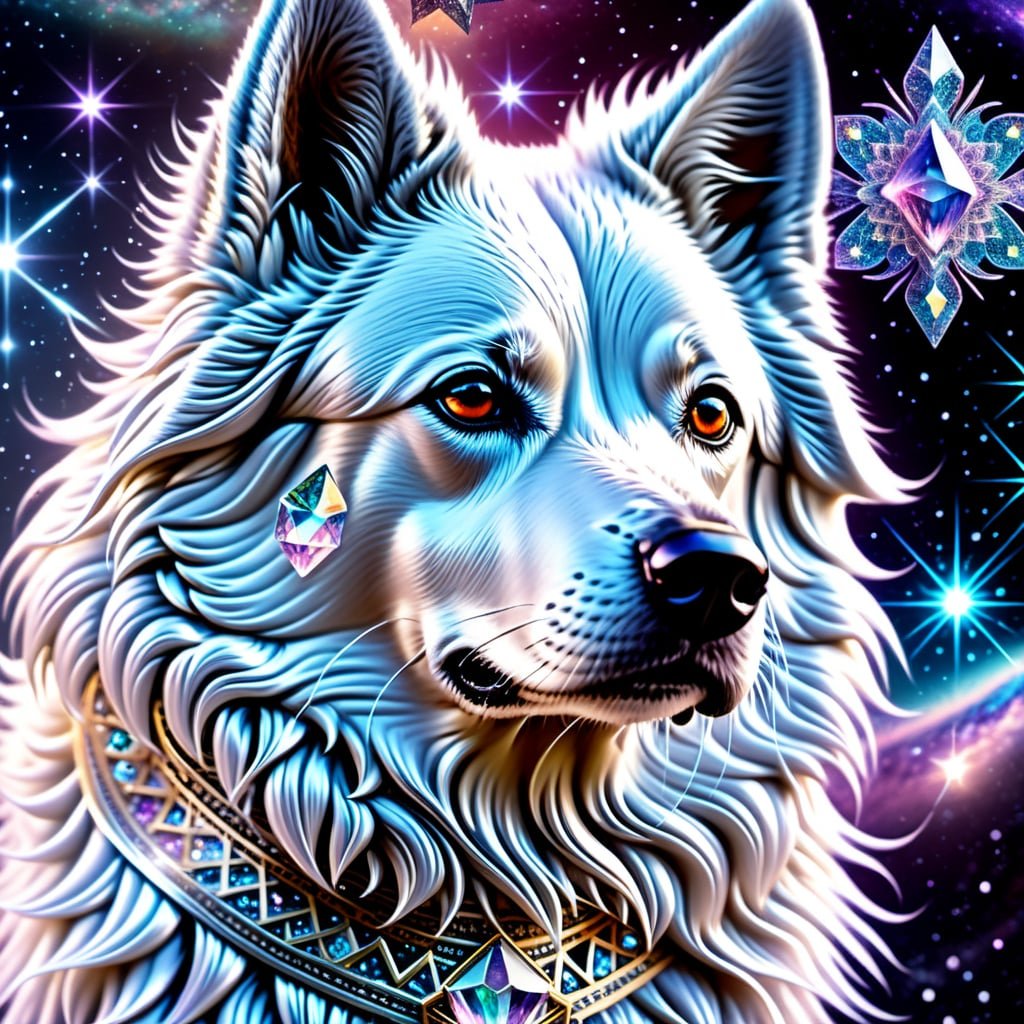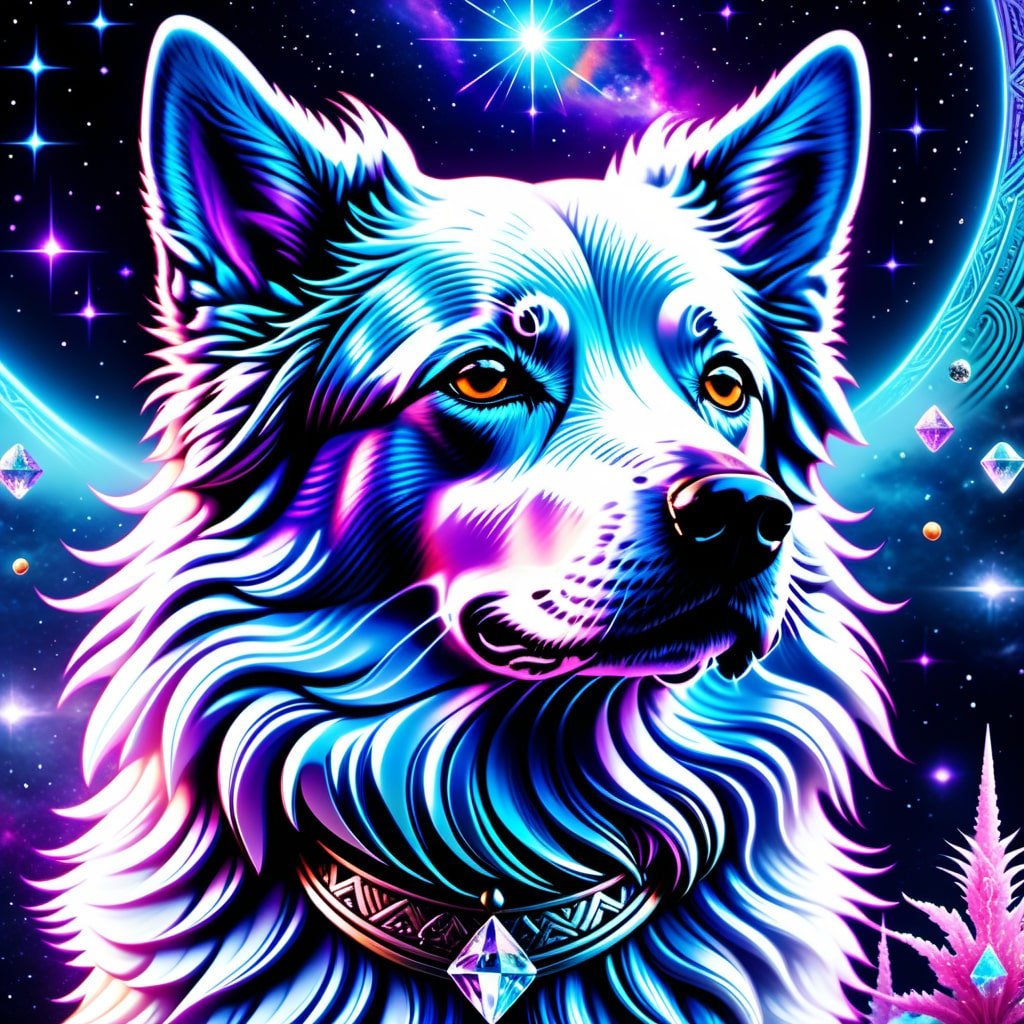Dogs & People: Neuroscience of Man's Best Friend & Evolutionary Ally
A Masterpiece of Co-Evolution: Exploring Humanity's Transformative Relationship With Our Canine Companions
Key Takeaways:
Domesticating ancient wolf populations contributed to human development of cognition, technology and emotional intelligence
Dogs assisted practical endeavors but also shaped human spirituality, art, self-identity across cultures
The human-dog bond has become emblematic of the core virtues defining "civilized" society
Canines may provide emotional grounding as humanity explores virtual/technological frontiers
Dogs continue inspiring human transcendence through their symbolic importance and unconditional love
Neuroscience of Man’s Best Friend & Evolutionary Ally, Hyperdimensional Portrait of an Astral Hound
For tens of thousands of years, humans and canines have been forging an inextricable bond that has fundamentally shaped both species. This symbiotic relationship dates back to the earliest days of wolf domestication, a pivotal turning point that not only gave rise to our beloved "best friends," but also may have catalyzed key developments in human cognition, technology, and emotional intelligence.
As a groundbreaking study from the University of Cordoba has revealed, interacting with dogs can induce relaxing brain waves similar to those achieved through meditation. This finding underscores the profound neurological impacts of our canine connections and hints at the transformative influence dogs have had on the human story.
Finnish Sami Poses with His Beloved Lapphund
Companions Through the Ages: Exploring Humanity's Profound Bond With Canines
For tens of thousands of years, humans and canines have been forging an inextricable bond that has fundamentally shaped both species. This symbiotic relationship dates back to the earliest days of wolf domestication, a pivotal turning point that not only gave rise to our beloved "best friends," but also may have catalyzed key developments in human cognition, technology, emotional intelligence, and consciousness itself.
Groundbreaking research from the University of Cordoba has revealed that interacting with dogs can induce a remarkable level of relaxation and neurological attunement in humans (Neuroscience News, 2023). By monitoring brain activity via electroencephalogram (EEG) sensors, the study found that petting a dog prompts a striking rise in gamma wave activity concentrated in the left cuneate nucleus - the same pattern seen in experienced meditation practitioners.
Hunting Companions in the Frozen North, Inuit Woman with Her Beloved Hunting Dog
These gamma waves are associated with absorption in a sustained positive emotional experience, coupled with decreased perception of negativity. Even more remarkably, this canine-induced gamma state appears to establish an "intention transmission" between humans and dogs allowing seamless synchronization of movements and communication.
Spirit of the Akita Inu, Hyperdimensional Portrait of a Japanese Ninja Wearing a Multi Patterned Silk Robe Posing With His Beloved Canine Companion
Our Canine Evolutionary Allies
Such findings suggest our ancestors' earliest interspecies connections with proto-dogs and wolves may have exposed them to novel neurological states - enhancing social attunement, emotional openness, and even higher cognitive functions. Simply by cohabitating with and bonding closely to these highly social, emotionally expressive canines, human brains could have been evolutionarily primed for pivotal shifts in consciousness.
The study authors posit that the affiliative hormones triggered by these close dog interactions - such as oxytocin, dopamine, endorphins, and prolactin - essentially "re-wired" ancient humans' neurochemistries. Constant doses of these bonding compounds, combined with enhanced gamma brainwave entrainment, may have propelled our ancestors into more expansive self-awareness and emotional intelligence.
Ancient Hunter on the Frozen Steppes Poses with His Dire Wolf Hunting Partner
This neurological foundation could help explain the cross-cultural prevalence of dogs featuring as guides, psychopomps, and symbolic representations of humanity's highest virtues and spiritual yearnings. From the emergence of the world's first artistic and mythological expressions to modern therapeutic interventions - our canine friends seem biologically destined to elevate our self-perception, emotional openness, and conscious states.
With this tantalizing scientific priming, we can explore how our partnerships with dogs have profoundly impacted spiritual, creative, technological, and civilizational development since the very dawn of modern humanity.
Delphic Oracle Poses with Her Beloved Alpha Wolf
The Paleolithic Partnership
Our millennia-old alliance with canids stretches back over 30,000 years to the Paleolithic era (Skoglund et al., 2015). During this prehistoric age, nomadic hunter-gatherers likely first "domesticated" populations of grey wolves that began following their mobile camps, forging a mutually beneficial partnership. For humans, having these proto-dogs around offered an early security system, alerting them to potential threats. Wolves, on the other hand, were able to scavenge nutrient-rich leftovers from the human hunts.
Over generations of coexistence and coevolution, the once-feared predators morphed into highly valued companions. Their inherent sociability, physical prowess, and human-attuned traits like facial muscle plasticity (facilitating expression and communication) made them exceptionally well-suited partners (Kaminski et al., 2019). With sophisticated wolf-derived traits like endurance, pursuit skills, and cooperation, these "domesticated wolves" became invaluable hunting allies for ancient humans.
Siberian Shaman Poses with His Beloved Hunting Dog to Celebrate the Arrival of Spring
As renowned anthropologist Brian Hare posits in his book Survival of the Friendly, this cooperative relationship was pivotal in the evolutionary divergence of humans' unique "human-like" sociocognitive skills, fostering brand new methods of communication, collaboration, and ecological problem-solving (Hare, 2020). By closely studying their wolf/dog companions' superb socio-ecological intelligence and adapting these strategies into their own "human culture," our ancestors were able to synchronize their cooperative minds in novel ways, spawning profound technological and behavioral revolutions.
The Woman Who Married the Bear, Finnish Folk Story, Surreal Portrait of a Huntress and Her Beloved Bear
The Cradles of Domestication
While the precise origin point of dog domestication remains elusive, advanced DNA analysis points to two major geographic centers where these pivotal human-canine bonds were formed: Western Europe/Siberia and East Asia (Lyu et al., 2022). In both regions, various indigenous groups engaged in vastly different styles of subsistence - from Arctic hunter-gatherers to complex agricultural societies of China. Yet all found invaluable partners in local wolf populations willing to coexist alongside human camps.
One of the earliest proto-dogs distinguishable from pure wolves emerged around 14,000 years ago among ancient Siberian populations. Dubbed the "Siberian Husky ancestor," this uniquely adapted lineage likely assisted the Lake Baikal hunter-gatherers and was prized for its cold-weather endurance and sledding abilities (Lyu et al., 2022). In parallel, European Paleolithic groups like the Mal'ta were forming comparably Close canine partnerships as far back as 28,000 BC (Lyu et al., 2021). From the frozen north to the fertile cradles of early civilization, a new era of interspecies cooperation was dawning.
Across the ancient world, symbiotic adaptations occurred as both species "domesticated" each other through generations of intense mutual learning and behavioral shaping.
Siberian Shaman Walks With His Alpha Wolf Dog on a Beautiful Spring Day
In East Asia, robust early agricultural societies like the Neolithic Yangshao culture readily enlisted "wolf-dogs" to assist with hunting, herding, and protection around 5000 BC (Pang et al., 2009). These canine helpers allowed the transition to settled life by safeguarding crops and livestock from pests and predators. They were so vital that evidence indicates they were afforded special burial rites akin to human members of the community (Pang et al., 2009).
The Middle East, too, proved a crucible for some of humanity's earliest and most enduring domestic dog lineages. In the ancient Fertile Crescent - the "cradle of civilization" - archaeological digs have uncovered dog remains interred alongside humans as far back as 12,000 years ago (Larson et al., 2012). For pastoral Neolithic groups, enlisting canine guardians and herders was indispensable for managing sheep, goats, and cattle fundamental to their sedentary village lifestyle.
These proto-dogs of antiquity came in many distinct varieties suited to the ecological demands of their regions - from sled-pullers of the Arctic to mastiff-like molossers ideal for intimidating livestock thieves. With each new phase of human civilization - from Neolithic villages to urbanized empires - the canine diaspora fanned out across the globe in a dazzling kaleidoscope of specialized breeds.
Running with the Wolf Clan, Portrait of an Ancient Hunter with hie Beloved Wolf Hunting Partner
Out of the Wolves' Den, Into Our Hearts and Minds
As humans and their canine companions grew increasingly interconnected across cultures, so too did our collective fates become deeply intertwined. Beyond the practicalities of hunting, herding, and protection, these "wolves-to-dogs" profoundly influenced the human mindset in more nuanced ways. New research suggests the very act of domesticating another species rewired our brains for greater social attunement (Hecht et al., 2012).
Living amongst, observing, and cooperating with these highly socially intelligent beings prompted a seismic shift in human mentality and survival strategies. Humans were, in a sense, "domesticated" as we grew attuned to subtle canine social cues and behaviors (Hare, 2017). We adapted our communication styles, adopting increased mutual gaze, vocal affection, and attentiveness to emotional cognition on par with wolves' nuanced pack dynamics.
Quantum Crystal Hound, Surreal Hyperdimensional Potrait of a Compassionate Astral Dog with Exuisite Gemstones
Moreover, dogs' infectious exuberance, playfulness, and affection may have helped catalyze human capacities for creativity, joy, and emotional bonding. Interacting with these ebullient companions produced neurological changes enhancing pro-sociality and self-regulation - key foundations for human cooperation and culture-building (Hare et al., 2002). As Carl Zillner eloquently theorizes:
"Being cared for by dogs, we became more human ourselves" (Zillner, 2020).
This inter-species bonding worked both ways, "domesticating" the once-wolves' psyches and shaping their neurochemistries and behaviors to become hyper-attuned to human cues, needs, and emotions over generations of co-evolution. Effectively, we assimilated key elements of canine "culture" into our own, while reshaping their ancestral lupine identities into the inquisitive, loyal companions of today's pet dogs (Hare and Woods, 2020).
Anubis and Anput, Hyperdimensional Portrait of an Egyptian Woman with Her Gold Wearing 24K Gold Ceremonial Jewelry
From Nomads to Navigators: Canine Aides Through The Ages
Whether nomads or navigators, hunter-gatherers, or empire-builders, human societies have universally depended upon and celebrated our remarkable canine partners for aiding key civilizational accomplishments. Many historians argue that the rise of settled agriculture itself was catalyzed and safeguarded by having "dog wolves" as protectors and enforcers (Coppinger & Coppinger, 2001). Throughout ancient history and across all inhabited continents, dogs played vital roles as:
Shamanic Hunting Dogs of Mexico, Hyperdimensional Sculpture
Hunting Allies
Virtually all ancient cultures co-opted the tracking, pursuing, and subduing abilities of proto-dogs to assist in hunting larger prey. From the Xoloitzcuintli "Mexican Hairless" hounds of Pre-Columbian Mexico to the fearsome Molossers of Archaic Greece, specialized hunting dogs were ubiquitous across the ancient world.
Royal Racing Dog of the Pharaoh, Greyhound Ancestor Wears a 24k Gold Egyptian Harness
Livestock Herders & Guardians
As humans transitioned from hunter-gatherer lifestyles to pastoral nomadism with the advent of animal domestication, specialized herding and guarding dogs became essential. Breeds like the Anatolian Shepherd Dog aided ancient Mesopotamians and Persians with managing vast herds of sheep and goats across the arid grasslands (Coppinger & Coppinger, 2001). Meanwhile, the legendary Mastiffs and Molossers protected entire villages and caravans from human and animal threats.
Japanese Ninja Poses with His Beloved Canine Companion
Beasts of Burden
The enduring power, strength, and loyalty of many indigenous dog breeds made them indispensable beasts of burden for Nomadic societies relying on sleds or travois. From the Canadian Arctic to Siberia, Inuit tribes and others enlisted tough sled dog breeds like the Qimmiq, Samoyed, and Siberian Husky to pull heavy loads across the tundra (Coppinger & Coppinger, 2016). Meanwhile, the short-legged Corgi herders doubled as hardy cart-pulling draught dogs for Welsh farmers.
Samoyed Alpha Poses with a Massive 24K Golden Bell and Leather Harness
War Dogs & Protectors
From the mastiffs guarding early Sumerian city-states to the fearsome Molossian dog warriors of ancient Greece, fierce canine sentries and weapons were ubiquitous among the militaries of old. Empires like Rome even instituted puppy-rearing programs producing disciplined attack dogs - the ancestors of today's protection breeds (Coppinger & Coppinger, 2001). These "armas canis" offered both psychological intimidation and ferocious assault abilities in battle.
Finnish Reindeer Herdsman Poses with His Beloved Lapphund
Hunters of Pest & Vermins
Beyond hunting big game, dogs' incredible scenting abilities made them indispensable for controlling vermin-threatening food stores and personal safety. Petite "terriers" like the Skye Terrier hunted down rats, mice, and badgers with merciless precision, while stouter breeds like the Dogo Argentino and American Staffordshire Terrier specialized in boar, bear, and big cat pursuit/extermination (Coppinger & Coppinger, 2001).
Quantum Anubis, Massive 24K Gold, Black Titanium, Emerald, Ruby Sculpture Installation
Ceremonial Companions
The profound bond between humans and dogs manifested in cultures worldwide treating canine companions with great spiritual reverence. Ancient Egyptians, Persians, Greeks, and many Native American societies facilitated a smooth "afterlife" journey for beloved dogs through ceremonial burial rites (Inskeep, 2003). In the ancient world, dogs frequently appeared in mythologies, artwork, and rituals as esteemed messengers, guides, and guardians between realms.
Astral Hound Looks on Lovingly Waiting to Guide You With Loving Compassion
The Genius of Genetic Cultivation
As the millennia passed and human civilization advanced, the mastery of selective breeding allowed the exponential diversification of distinct dog breeds. Humans systematically cultivated specific lineages to amplify desired traits - be it size, strength, affability, or working intelligence - creating specialized genomes ideally suited for various traditional roles and environments (Coppinger & Coppinger, 2001).
From the powerful Mastiffs and herculean St. Bernards bred as bodyguards and rescue allies, to the lithe, keen-nosed scent hounds perfected for culling foxes and badgers, societies worldwide practiced an agricultural form of genetic engineering. The diversity of modern global "man's best friends" stands as a lasting testament to the patience, ingenuity, and passion of our ancestral human-dog collaborations.
Man’s Best Friend, Supreme Quantum Canine Commander, Surreal Hyperdimensional Portrait with 24K Gold, Black Titanium, Emeralds, Labradorite, Ruby, Amethyst
The genius of this evolutionary human-guided dispersal of canis domestication is exemplified by breeds like the Akita of Japan. Developed from ancient spitz-type dogs, the muscular, courageous Akita pulled double duty: a versatile hunting companion by day and steadfast family protector by night (Coppinger & Jones, 1999). With their wolfish appearance yet unwavering loyalty, Akitas embodied the symbiosis humanity had forged with the canine species over the ages.
Spirit of the Finnish Lapphund, Hyperdimensional Sculpture with Surreal 24K Gold Harness and Massive Bells
Howling New Horizons: Society-Shifting Impacts
As instrumental as dogs were in aiding practical human endeavors, their partnership profoundly catalyzed more abstract evolutionary developments in our species - transforming our very cognition, abilities, emotional lives, and self-perceptions.
Co-evolution with canine companions may have sculpted key advances in human socio-cognitive abilities and culture. Some hypothesize that by observing wolves' sophisticated social intelligence and hierarchies, hunter-gatherers developed enhanced capacities for cooperation, egalitarianism, and even grammatical language (Miklósi & Kubinyi, 2016).
Similarly, the intense bonding and nurturing required in domesticating dogs likely shaped pro-social circuitry and parenting instincts in the human brain (Bradshaw, 2017). This interspecies oxytocin-mediated attachment laid the foundation for our exceptional emotional intelligence and capacity for adoption/socialization beyond kin.
Siberian Shaman Poses with His Beloved Husky Alpha
Our Eternal Spirit Guides
Dogs' infectious exuberance and playfulness may have nurtured human capacities for joy, exploration, and creative thinking. After all, honing a deep communicative rapport with a different species requires imagination and innovative problem-solving (Hare & Woods, 2020). This interspecies "dance" could have boosted human cognitive flexibility.
More tangibly, dogs enabled key technological transitions like the invention of sleds and wheels by offering a controlled means of draft power. Their tracking abilities catalyzed the creation of primitive navigation/mapping systems. Even humankind's transition from nomadic to settled living was likely facilitated by dogs' talents for herd management and territory control (Coppinger & Coppinger, 2001).
Prehistoric Alpha Hunter Stalks the Ancient Wilderness with His Dire Wolf
Ultimately, as humanity's first domestic companions, dogs helped shape our self-perceptions in pivotal ways. We gained a new lens into our pack-oriented social behaviors - both noble and brutish. Having an interspecies counterpart amplified our self-awareness and sense of transcendental human identity (Fromm & Froom, 2004).
Quantum Great Dog and Marcus Aerlius, Massive Surreal Sculpture Installation 24K Gold, Titanium, Emerald
Great Dogs Make a Strong Kingdom
Our canine companions became inextricable from cultural definitions of "civilization" itself. In ancient Mesopotamia, Greece, and beyond, dogs represented humanity's ideals of friendship, fidelity, vigilance, and unconditional devotion. Philosophers from Plato to Marcus Aurelius pondered the "Great Dog" as a moral and spiritual paradigm.
Quantum Canine of Radiant Compassion, Majestic Sculpture of a Heavenly Hound Made of 24K Gold, Polished Silver, Black Titanium, Ruby, Sapphire, Labradorite, Tourmaline
Indeed, the reverential status afforded dogs in ancient rites speaks to the deep spiritual dimensions of our bond. Hindu vedas associated dogs with life force and "prana." Persian, Inuit, and Greek traditions envisioned packs roaming the afterlife, assisting the soul's transition. In Egypt, dogs symbolized the souls of deceased pharaohs and gods themselves.
Thus, the very notion of being "human" became intertwined with our canine familiars and all they embodied - loyal guardians, steadfast companions, and fervent believers in humanity's higher potential. Just as they enabled our physical exploration of the world, so did dogs spark an inward journey of philosophical inquiry and self-discovery that birthed human civilization.
Special Forced German Shepherd with Black and Gold Body Armor Poses with Her Human Partner
A Healing, Hairy Homecoming
Today, in our hyper-modern human condition of skyscrapers, smartphones, and virtual realities far removed from nature, the human-dog bond remains an eternally anchoring touchstone to our wild, emotionally resonant core identities. Scientific research reveals that the mere act of petting a dog releases wellness-promoting hormones like oxytocin, serotonin, and prolactin while reducing cortisol (Shiloh et al., 2003). Canine companionship mitigates anxiety, and loneliness and even enhances pain management (Sobo et al., 2006).
At a time of unrivaled loneliness, disconnection, and alienation from the natural world, dogs have come full circle to reconnect us with our ancestral spirits. Whether service animals for the disabled, emotional support companions for the traumatized, or obedient family protectors, our bonds with our "Old Dogs" harken back to a primordial interspecies kinship.
Indeed, dogs may again be assuming an archaic role: helping humans cultivate the compassion, grounding, and ancient wisdom needed to navigate ambitious technological domains.
Hyperdimensional Astral Dog of Radiant Love, 24K Gold, Black Titanium, Tourmaline, Diamond Cosmic Dog Sculpture
Legendary Allies and Eternal Canine Friends
As our species' first interspecies collaborators, canines once sparked key advances in human cognition, emotion, and civilization itself. Now, by simply walking beside us, nuzzling our hands, and gazing into our eyes, dogs provide a conduit back to our rooted, emotionally attuned selves amidst the digital cacophony.
Through their intuitive emotional sensitivity, dogs can attune to our most subtle psychological states, becoming furry emotional support networks. Studies show service dogs can detect emotional distress and physiological signals like impending panic attacks or diabetic shock before their human handlers (Berns, 2017). In this way, dogs stand ready as our ancient evolutionary "buddies" to provide warmth, safety, and self-regulation.
Astral Hound in a Surreal Digital Vapor Dream
For children on the autism spectrum or with other developmental challenges, interactions with dogs have demonstrated profound therapeutic benefits. Playing and tending to a dog bolsters emotional intelligence cultivates nurturing behaviors, and reinforces routine - all key developmental needs (Kern et al., 2011). Dogs inherently model virtues like patience, empathy, and unconditional acceptance that can facilitate breakthroughs.
In the clinical realm, dogs' intuitive cross-species emotional attunement allows them to ease psychological suffering in ways even human counselors cannot. By providing affection, comfort, and intuitive mirroring free of judgment, dogs bypass intellectual defensiveness to rekindle warmth, openness, and spontaneity (Hamama et al., 2011). Their gentle psychobiological presence makes them ideal adjuncts for PTSD, depression, and anxiety therapies.
Snowy White Dog Poses in a Winter Wonderland Wearing a Massive 24K Gold Bell
These emotional endorsements offer a warm respite from loneliness while validating our most fundamental human needs for connection, touch, play, and being accepted without pretense. Just as our "best friends" once inspired humanity's first symbolic, cultural, and spiritual stirrings, they now provide an anchoring counterweight to our increasingly virtual, transhumanist trajectories.
For all our scientific sophistication and transcendent ambitions, canine companions remind us to retain our core, earthy "human-beingness" - playful, soulful, socially attuned, and deeply bonded to the primordial rhythms of Nature that first sparked our extraordinary co-evolution. Our future flights may explore galactic frontiers, but with our "Old Dogs" by our sides, we'll never completely lose our planetary roots and biophilic identities.
Rugged Ancient Bow Hunter Hunter with His Dire Wolf Alpha
A Masterpiece Millions of Years In The Making
In surveying the profound impacts and intricate co-evolution of humanity and canines over tens of thousands of years, one cannot help but be struck by the sheer grandeur of this interspecies relationship. What began as a tenuous, fearful encounter between two wildly different species blossomed into one of nature's greatest cross-kingdom partnerships and most enduring epics of mutual transformation.
From providing the practical edge that allowed our ancestors' survival and expansion, to serving as catalysts for revolutionary shifts in human cognition and emotional intelligence, dogs have been instrumental in sculpting our species' unique self-conception and consciousness. Even now, as we become hybrid techno-biological entities, the essence distilled by our canine collaborators keeps us rooted in intuitive, compassionate "human-beingness."
Crystal Hound of the Golden Mystery, 24K Gold, Black Titanium, Rubies, Saphires, Hyperdimensional Finnish Lapphund Sculpture
In many ways, the human-dog relationship is Nature's timeless masterpiece - a tapestry interwoven through millennia and motifs. Predator became a protector. The Wolf pack became a nuclear family. Mythological guardians morphed into living emotional anchors and angels. Curiosity became cross-species communion. Our story with dogs continues unfolding like a grand, shaggy eternal poem comprised of heroism, loyalty, comedy, tragedy, unconditional love, and, ultimately, mutually catalyzed transcendence.
As we consider the monumental impacts of our deep canine connections, perhaps the greatest collaboration and co-evolution sparked has been of our very souls. By teaching us to love, nurture, and forge enduring kinship across the species divide our "Old Dogs" revealed our extraordinary capacities for empathy, compassion, and spiritual friendship. This legacy now stands as the bedrock of our humanity and path forward into the cosmos. When we inevitably encounter new intelligent beings among the stars, we'll bring all the wisdom gleaned from our first, and forever, companions - the "Old Dogs" forever guiding us Home.
Sami Reindeer Herdsman Hunts with His Beloved Finnish Lapphund Alpha
Finnish Lapphund: An Ecological-Spiritual Case Study
Among the ancient dog breeds inextricably woven into a rich cultural-spiritual tapestry, few exemplify the profound synergy of human, canine, and environmental relationships like the Finnish Lapphund. Emerging from the semi-nomadic Sami reindeer herding peoples inhabiting the boreal forests and Arctic tundra of northern Fennoscandia, the Lapphund embodied the ecological consciousness of a subsistence society utterly intertwined with the ebbs and flows of the natural world.
Bred as versatile working dogs capable of herding the all-important reindeer while also protecting the camps from predators like wolverines and bears, the spitz-type Lapphund was a vital lynchpin in the Sami's spiritual understanding of their place within the cosmos.
These "reindeer's dogs" enabled humanity's harmonious participation in the great cycles of migration, death, rebirth, and regeneration driving all life across the Arctic landscapes. Without the Lapphunds' talents for controlling reindeer movements, guarding, hauling sleds and even warming the night watches - the Sami's nomadic reindeer pastoralism would have been untenable.
But beyond their practical roles, the Lapphunds achieved an exalted, mystical significance as intermediaries and ambassadors allowing reciprocity between the human, reindeer, and greater Nature realms. Their unwavering loyalty, high energy, and "keening" vocalization abilities made them seem like conduits through which the Sami received sacred communications from the unseen forces governing the cosmos.
Finnish Lapphund Poses on a Snowy Day Wearing a 24K Gold Harness and Bell
Lapphunds And the Northern Expansion of Consciousness
In Sami cosmology, all aspects of existence - from the migratory paths of reindeer herds to the very forms of Lapphunds themselves - manifested the metaphysical interplay of vital energies and spirits permeating the material world (Kuoljok, 2011). The great reindeer (boazu) were understood as intermediaries between the human world and the realms of hájja (ancestral forces) and radien (protective forces). Lapphunds, through their symbiotic working roles alongside both humans and reindeer, became psychopomps capable of navigating these metaphysical dimensions.
During annual reindeer migrations across the Arctic tundra, the howling and barking of Lapphunds took on divinatory significance, their vocalizations seen as transmitting messages from radiant spirits about herd movements, environmental omens, and even the well-being of the Sami community itself (Grønfeldt, 2020). Lapphunds' eagerly awaited behavior at denning times served as harbingers of the upcoming cyclical shifts in seasons, reindeer calving patterns, and human subsistence activities.
The breeds' wolf-like appearance only heightened their numinous status, as the Antarctic wolf (rouktok) occupied pride of place in Sami creation myths as the original pathfinder animal leading the way for all life's proliferation across new lands (Sveen, 2003). Thus, Lapphunds embodied the primordial, mysterious essence of Nature - at once feared and revered conduits into the deepest, most ancient root systems of life's regenerative pulsations.
Sami Shaman Poses with His Beloved Lapphund who is Wearing Reindeer Antlers
Mystic Guides to the Psychospiritual Landscape
The Lapphunds' profound attunement to this rhythmic environmental consciousness influenced even the architectural practices and traveling patterns of the Sami people themselves. The migrational cycles of reindeer herds guided by Lapphunds served as the theoretical template for designing and orienting the cosmic architectural forms of traditional Sami portable tents and subterranean gamma dwellings (Kjellström, 1983). The oblong layouts, tunnel entrances, and precise cardinal directions of these nomadic structures all emerged through observing the trackways and rest patterns established by reindeer herds—as conveyed by the herding Lapphunds themselves.
Similarly, the Lapphunds' vocal sensitivity to the changing atmospheric dynamics and weather patterns presaging reindeer migrations allowed the Sami to organically adapt their own travels and habitation sites to the most hospitable regions each season (Kjellström 2004). The dogs' amalgamated roles as environmental diviners and livestock pilots made them arguably the most centrally influential force shaping the Sami's entire nomadic culture and metaphysics.
This exalted status culminated in the Lapphunds becoming vicariously imbued with spiritual powers, often adorned with mystical symbols like the bear-claw amulets intended to channel protective energies (Urbańczyk, 2022). During certain traditional Sámi rituals, specific Lapphunds may have even served as living incarnations of radian entities, allowing spiritual communications and blessings to physically manifest.
In Norse mythology as well, the Sámi (or "Finns" as they were known) were famed as accomplished sorcerers capable of shapeshifting between human, canine, and other animal forms at will (Tolley, 2009). These transformative spiritual mastery skills were intimately linked to their reindeer husbandry practices and the Lapphund partners were vital to that subsistence tradition.
Majestic Sable Finnish Lapphund with a 24K Gold Bell in a Snowy Paradise
Wolf Families of the Frozen North
Many scholars believe the widespread European notion of werewolf or "skinwalker" legends originated from these shamanistic reindeer herding cultures and their symbiotic relationships with dog wolves like the Lapphund. To the Sami themselves, the ritualistic donning of reindeer pelts and acting as "reindeer beings" guided by their canine mystics was a sacred endeavor - a conscious embracing of the pan-species permeability and shape-shifting cycles of the great Arctic lifeways (Tolley, 1994).
On a more down-to-earth level, Lapphunds' famous calming effects on skittish reindeer reflected an intuitive emotional attunement believed to transcend mundane human-animal bonds. The breed's ability to perfectly modulate their barks, body language and even starting gazes allowed effortless communication and energy transmission with the reindeer herds (Corren, 1994). Reindeer responded to Lapphunds in ways they simply did not with human reindeer herders alone.
This uncanny rapport spoke to a sort of primordial "language" the two species shared - a biocommunicative network of vocalizations, movements, and physiological signals allowing a seamless synchronization of herd consciousness between the reindeer and human realms (Parlee et al., 2005). Lapphunds stood as essential conduits traversing these interspecies boundaries, their unique attunement to both human language and reindeer biorhythms ushering understanding and cohesion.
Quantum Lapphund, 24K Gold, Black Titanium, Silver, Emerald, Ruby
Deep Ecological Relationships
The Lapphund's indispensable sociocultural role simultaneously connected the human, reindeer, wolf/dog, and plant worlds in an exquisite, interconnected fractal of consciousness ecology. While the reindeer sustained the Sami diet and very lifeblood, the reindeer's migration patterns were inextricably guided by the available plant foodstuffs - particularly lichens like reindeer moss and mushrooms like the psychedelic Amanita muscaria (Buga, 2022).
These hallucinogenic mushrooms, in turn, played pivotal roles in Sami ritual practices and worldviews surrounding the very concepts of reindeer and Trans-species communication. The vivid visionary states produced by Amanita allowed Sami shamans and herders to experientially inhabit the expansive perceptual cosmologies of the reindeer themselves - ultra-sensory modes of awareness finely tuned to lichen distributions, barometric pressures, lunar cycles, and migrating bird patterns (Pollan, 2018).
The ingestion of these mushrooms was traditionally preceded by rituals involving the Lapphunds - the canine allies able to metabolize the same compounds while retaining semi-lucid, dreamlike consciousness states. By psychically attuning to the Lapphunds, Sami practitioners felt they could access the deeper streams of environmental consciousness and reindeer-messaging abilities their four-legged companions channeled while working in altered mindstates.
Thus, the human-Lapphund-reindeer-mushroom relationship functioned as a recursive feedback loop of expanded ecological awareness and entheogenic mindstates. Each element - the migrating reindeer consuming hallucinogenic mushrooms, the Lapphunds metabolizing the compounds from eating reindeer lichen/droppings, and the Sami ingesting the mushrooms to inhabit these trans-species spheres of perception - collectively opened gateways into penetrating Nature's cybernetic information networks at their deepest psychoactive levels.
This totality coalesced into remarkably nuanced, sustainable traditions of reindeer husbandry, in which the herds were guided along trans-continental migratory paths with few human interventions - simply the gentle biocommunicative accompaniment of the Lapphunds (Beach, 1981). The dogs' symbiotic presence seemed to attune the reindeer into listening to the same planetary biorhythms and seasonal cues the Lapphund handlers themselves entered through visionary mushroom journeys.
Friendly Sable Colored Finnish Lapphund Lovingly Awaits Its Next Command
Sacred Solidarity Forged in Alliance with Nature
In this cosmic choreography adjudicated by the Lapphund's conscious and sublimated reindeer whispering, the entire culture achieved a sort of cybernetic resonance with the land itself. The Sami's nomadism became less a wandering in search of sustenance, but a ritual peregrination tracing the grand migratory paisleys woven across the Arctic by the interspecies consciousness field they participated within.
As such, the Lapphund served as the critical bridge - operating with hooved and human associates in Dreamtime mindstates inaccessible without the visionary mushroom conduits, while retaining rootedness in the terrestrial realms of scent, vocalizations, and body language so crucial for reindeer guidance.
The breed's famed blueish-black tongues, a rare genetic trait, even took on symbolic significance as physical embodiments of the crepuscular, ultraviolet-exposed planes of trans-species awareness they seemed to traverse (Samekultur, 2011). Lapphunds'UItra-black vibrissae (whiskers) were similarly revered as tuning rods channeling the subtle environmental ESP that guided entire Sami villages and reindeer herds across vast Arctic distances using nothing but these dogs' subliminal tracking signals.
This comprehension of Lapphunds as living biocybernetic intermediaries between the physical, metaphysical, and "planetary mind" spheres manifested in the intricate symbolic decoration of their gear and regalia. Traditional Sami beska handicrafts like the Lapphunds' skin-sewn harnesses incorporated designs representing the syncretic cosmologies - a vibrant tapestry interlacing elements of Norse mythology, Finnish folk traditions, animistic nature symbolism and, most reverentially, direct representations of the reindeer's metaphysical significance (Kulonen et al., 2005).
Prime beska motifs feature intricate variants of the Bear Constellation guided by stylized arced "reindeer antler" forms, embodying the Lapphunds' role as navigators following the reindeer exemplars across the great celestial caravan routes (Solbakken, 2007). Other traditional designs depict sun-centered circular mandalas with reindeer spirits migrating between "worlds" - the Lapphund acting as the hub channeling these transcendental journeys.
Astral Dog Sails Through the Quantum Multiverse, Surreal Portrait of a Friendly White Dog Wearing a 24K Gold, Labradorite and Quartz Collar Flying Through Space
Mystical Bells as Ancient Frequency Healing Tools
Even the dogs' traditional bells produced ultra-low frequency tones believed to both calm reindeer herds and summon animal helper spirits from the unseen realms during Sami shamanic rituals (Chevalier, 2015). The same bells were used as aural anchors helping humans, reindeer and Lapphund alike maintain collective synchronization during ritualized reindeer "rebirths" where the great herds encircled the indigenous Sámi drums and mushroom-induced trance states.
Ultimately, the Lapphund breed became an irreplaceable member of the extended "ecological family" unit for the Sami - functioning as midwives, psychopomps, spirit guides, and consciousness ambassadors allowing full participation in the great symbiotic dances of the Arctic bioregions. More than just herders and guardians, these remarkable canines opened metaphysical gateways into the pulsating, root-level life streams of an unimaginably vast, interconnected Hylocomium/Amanita/Cervidae consciousness network.
Their "dogness" made them capable of merging with both human and reindeer mindsets, while still embodying the tantalizingly ineffable essence of Nature's inexplicable mysteries. As such, Lapphunds may represent one of humanity's earliest and most revelatory encounters with the infinite possibilities for expanding consciousness - both our own and the planetary totality we're indelibly woven within.
For it was through millennia of attunement with these lustrous ambassadors, that the Sami harnessed the cognitive tools to overcome more limited, anthropocentric perceptions and inhabit the panoramic ecological awareness fields incarnate in every Lapphund's piercing gaze. Their eyes, like obsidian pools, reflect a universe of ancestral, interspecies revelations awaiting full metamorphosis in the continually re-birthing human mind.
Quantum Spitz, Protector of the Gaiian Nexus Crystal at the Hyperion Command wearing a Hyperdimensional Black Leather, 24K Gold, Ruby and Saphire Spirit Collar
The Sublime Interconnection
In the high Arctic valleys where Lapphunds, their humans, and the reindeer first formed world-rede bio-symbiogenesis, the greatest secrets of life's sublime connectivity may have been uttered - heard only by those open to awakening their slumbering senses of cosmic consciousness so clearly embodied in these striking mushroom gurus of the First Nomads.
This ancient Lapphund wisdom challenges modern humanity to follow where our humble, hairy guides first led - beyond the cloistral confines of ordinary perception, into a ceremonial embrace of the infinite intelligence and interdependencies pulsing across our planetary dreamscape. In doing so, we may finally elevate into the unbounded, trans-species alliances and understandings our very evolution, and Earth's grandest life cycles, seem to beckon.
Luku closed the great Arctic attunement beckons. Let the Lapphunds lead the way, as they once did, towards the transcendent symbiogenesis and communion of all Life's dreaming. Only then will we fully reintegrate into the cosmic choreographies and visionary circuits we were born to joyously inhabit alongside our first, and eternal, companions through the ages.
Dogs & People: Celebrate the Magical Connection Between a Sami Reindeer Herdsman and His Beloved Alpha Wolf Dog
Heavenly Hounds: Canine Influences on Human Spirituality and Creativity
Since the dawn of human civilization, canines have represented far more than mere utilitarian helpers or workers. Our partnerships with these remarkable beings have transcended practicality, weaving together the very spiritual, creative, and symbolic fabrics that came to define ancient cultures worldwide.
Dogs' unfathomable loyalty, fierce protectiveness, and ecstatic enthusiasm made them ideal totems embodying humanity's highest virtues and most mystical yearnings. It's no surprise that dogs emerged as potent symbols, icons, and emissaries of the divine across numerous ancient spiritual traditions and origin myths.
Xolo Spirit Guide, Surreal Hyperdimensional Sculpture of a Two Headed Mexican Dog
The Spirit Guides at the Crossroads
For the Indigenous traditions of Ancient Mexico, revered "xolo" dogs were seen as emotionally bonded psychopomps - beloved guides escorting the dead through their underworld journeys. The wispy-haired xoloitzcuintli acted as chthonic VIPs, to be ritually buried so their spirits could continue accompanying the deceased towards the afterlife (Flores et al., 2015).
Majestic Guard of Horus, Surreal Portrait of Ancient Egyptian Racing Dogs Wearing Ceremonial 24K Gold and Gemstone Armor
In ancient Egypt, sleek and regal greyhound-like Salukis were the "Horus Guards" tasked with ushering departed souls to be judged by the jackal-headed deities. These graceful "Persian greyhounds" embodied the perfect equilibrium between elegant strength and sublime loyalty that ancient worshippers aspired to for both this world and the next.
Divine Unconditional Love and Protection of Sacred Hounds in Ancient Persia, 24K Gold Sculpture
Meanwhile, in ancient Persia, dogs represented the very embodiment of the universal force of creation and light. The Zoroastrians venerated "dog beings" as spiritually emanating from the Divine Unconditional Love and Protection at the Crux of all existence (Khursheed, 2004). The humble street dog was seen as the physical manifestation of the highest, most nurturing cosmic power imaginable.
Surreal Mystical Portrait of Ancient Viking Wolf Dogs Depicts the “Magical Ear of the Hound”
Similar exalted reverence for canines pervaded the Norse Viking cosmology. Legends held that at the world's edge, a mighty pack of dubiously loyal "watchdogs of the gods" stood guard through the ages (Sturluson, 2005). These sleepless sentinels were pledged to sound their howling horns at the first sign of the apocalyptic arrival of evil forces, defending the very existence of the heavenly realms and their gods. Such feverish fidelity and vigilance in dogs evoked the highest modes of sagacity and underdog courage.
The Majestic Legend of St. Bernard, 24K Gold, Polished Silver, Diamond, Saphire, and Ruby St. Bernard Protector of Humanity
Transcendental Muses for Humanity's First Artworks
In arguably history's first explosion of artistic and symbolic creativity, dogs played a starring role in inspiring ancient humans' initial awakenings of abstract expression and visual storytelling. The famous cavernous paintings of Chauvet, Lascaux, and Altamira are dominated by stunningly vivid canine forms sharing spiritual space with wild ungulate hunting.
Whether faithfully posed alongside their ancestral wolf brethren or metamorphosized into supernatural, hybrid beasts, historians believe the ubiquitous "dog figures" reflect the very first expressions of human symbolic language and reverence for interspecies synergy (Shipman, 2015). Our ancient forager ancestors seemed to honor the profound shifts in themselves catalyzed by cooperative relationships with domesticated wolf partners. In essence, they yearned to immortalize what it meant to become "human" in our primordial, co-evolutionary awareness alongside the first "dogs."
Ancient Japanese Ninja Poses with His Beloved Akita Wearing Ceremonial Battle Armor
As the artistic revolution continued into the ancient civilizations of Mesopotamia, Persia, and beyond, dogs were featured as central icons and protective symbols. Artifacts like the exquisitely crafted Puabi funerary regalia depict lovingly rendered canine companions leading the dead into the next world while lions hover obediently (Pittman, 2002). Meanwhile, intricate cylinder seals and friezes show regal, wolfish dogs standing sentinel as guardians and talismans, blending their spirits with those of the kings and deities they defended.
Such symbolic overlays spoke to the mythic, almost supernatural manner in which ancient cultures perceived their esteemed canine allies. In their steadfast loyalty, tendencies for spiritual companionship, and roles assisting in life's most powerful transformations (hunting, warfare, death/rebirth), dogs encapsulated profound human virtues worth venerating through transcendent art forms.
Despite such enduring global traditions enshrining the symbolic importance of dogs, the species has also faced profound cruelties and ethical battles in the modern era. From the over-commodification of puppy mills to the very existence of the dog meat trade in some Asian cultures, there remains an undercurrent of canine exploitation that activists have rightfully challenged.
Ancient Bow Hunter Poses with His Dire Wolf Companion
The dog meat trade in particular has inspired global protest movements and efforts to legally ban the practice in nations like South Korea, China, and Indonesia where it lingers. While a small percentage of these populations view canine consumption as a culturally entrenched norm, the overwhelming majority of modern Asian societies have come to embrace dogs as beloved companion animals deserving of full protection (Kim, 2008).
At the same time, growing trends in pet obesity, animal hoarding, and an infinity of Internet-memed dogs in human clothing have sparked philosophical debates around projected anthropomorphism. As our loved "fur babies" become increasingly humanized themselves, some wonder if we've lost touch with respecting the inherent "dogness" of our canine friends.
Leading ethicists encourage a return to celebrating dogs for who they are as a species - not diminutive humanoid substitutes, but remarkable beings with unique intelligence, behaviors, and needs (Gruen, 2015). Treating dogs as interconnected partners worthy of dignity on their terms is key, they argue.
Perhaps it's this very delicate reverence that ancient traditions exemplified so powerfully in their canine-inspired sacred arts and myths. Rather than possessing or infantilizing dogs, these civilizations seemed to recognize and channel the fundamental asymmetries and ineffable mysteries embodied in our mismatched cross-species relationships.
Xolo Spirit Guide of Ancient Mexico
In the Eternal Re-Birthing of "Civilization"
At the deepest level, the human-dog bond has become emblematic of the very notion of "civilized society" itself in both ancient and modern contexts. Our abilities to transcend brutish instincts and cultivate higher qualities of empathy, loyalty, tenderness, and playfulness - all seem to hinge on maintaining our kinship with canine ambassadors of the heart.
When war-torn regions like Afghanistan, Iraq, or the Balkans begin rebuilding towards peace and civility, some of the first signs are an increase in beloved family dogs, once again roaming the streets companionably. The very resurgence of trust and capacity for collective vulnerability is a canine code for "we're okay now" in the wake of societal trauma (Bradshaw, 2011).
On the opposite end of the spectrum, recent archaeological discoveries have found elaborately buried dogs interred with unparalleled funerary riches at the very cradles of the earliest civilizations - Mesopotamia, Iran, and Central Asia (Oakes & Gahtan, 2016). These "dog nobles" reveal how profoundly early cities coded canine relationships into their highest spiritual, political, and cultural identities.
The Immaculate Healing Aura of St. Bernard, 24K Gold, Polished Silver, Black Titanium, Ruby and Emerald Sculpture
The tale comes full circle to our present-day military and service dog programs. The very cutting-edge human capability - representing emotional resilience, battle-readiness, heroism, and transcendent care for the vulnerable - is embodied in the very same interspecies partnerships that may have sparked the advent of "civilization" itself (Berns, 2017).
Whether ushering us collectively to the rediscovery of our compassion after times of torment or serving as steadfast allies for achieving new frontiers of human potential - dogs maintain their sacred role as mirrors, guides, and embodiments of our highest, most tender selves. Our continued ability to embrace these proud, playful yet heroic beings as beloved partners and family members reflects an ongoing commitment to upholding the core virtues crystallizing us as a truly "civilized" species.
In this eternal canine-human cycle of death, renewal, transcendence, and rebirth lies the very heart of what's meant by "becoming human" over and over again. When we inevitably lapse into fear, violence, and shuttered brutishness as a species, it is so often the humble dog who reawakens our latent capacities for tenderness, joy, faith, and inner-attunement.
Astral Canine Waits Lovingly to Support You in Every Possible Way
Canine Guides of Consciousness
Our canine companions beckon us back from the abyss of dehumanization, reigniting the hearth of civilization within. They manifest the symbolic essence of our philosophical, creative, and spiritual strivings for connection, unconditional acceptance, wonder, and soulful resonance with the cycles of nature.
In this light, the recent flourishing of animal-assisted therapy practices positions dogs as modern psychopomps and healers - using their mythic potencies to gently coax people through psychological transitions, trauma recovery, emotion regulation, and restoration of playfulness. Our immanent friends model the way back to wholeness.
At a time when virtual realms threaten to sever humanity's last tangible connections to our biophilic roots, dogs stand regarding us with ancient, unblinking eyes. These irises pool with the sacred waters of a million transcendent campfires burning across the archaeological record - continually rekindling a primordial human-dog communion born before civilization itself.
In those profoundly grounding moments we still sometimes experience while hiking forest trails, sitting in backyards, or greeting a neighbor's wagging tail - our late-evolving species remembers its origins as humble, awestruck foragers first beholding the majesty of lupine hunting partners willing to join our nomadic family. We're reminded that such interspecies partnerships sparked the seminal kindling for art, language, play, abstract thought, and spiritual conception.
These deep memory embers have been carefully banked and fueled by legendary human cultures who enshrined dogs as icons, tale-tellers, mystical guides, and living totems for the highest virtues. Thanks to their symbolic veneration, dogs stand poised to resume their ancient ambassadorial role - sharing direct passage back to the cradles of human creativity, tenderness, curiosity, and indomitable spirit.
The Golden Hound of the North, Surreal Oil Painting of a Finnish Lapphund Alpha
So as artificial intelligence, virtual worlds, and unabated environmental upheaval loom on our civilizational horizons - who's to say the answers don't lie in reconnecting with the humblest, hairiest, most faithful sources of unconditional love and untrammeled imagination? Our"best friends" have been waiting, with trademark patience and loyalty, to once again unleash their preternatural influences on the human potential for transcendental spirituality, reverence, and storytelling.
Perhaps it will be in dreaming new chapters of an ancient, canine-inspired human epic that we, as a species, come to know the most elevated possibilities of our shared destiny on this pale blue dot. As we wonder and wander back towards the indelible essence of soulful emotional intelligence first sparked by twinklings from the once-wild eyes of wolves - the heavenly hounds remain poised to usher us into whichever mystical possibilities we can envision next.
Hail Barry, the barrel-wearing St Bernard who saved 40 lives as a mountain rescue dog. This legendary canine hero, born in 1800, was part of the famous rescue dog squad at the Great St. Bernard Hospice in the Swiss Alps.
A Call To Reawaken Your Primordial Partnership
The human-canine relationship represents an eternal wellspring of creative potential, emotional rejuvenation, and profound intersecies connection awaiting rediscovery. By reawakening our ancestral bonds with these remarkable beings, we can access inspired pathways for individual and collective transformation.
At Ultra Unlimited, our multi-disciplinary offerings provide immersive experiences allowing you to rekindle the transcendent essence embodied by our canine guides throughout the ages. Whether through animal-assisted creative workshops, wilderness retreats focused on reintegrating dog-human coherence, or personalized canine shamanic coaching - we facilitate profound journeys of the self while honoring our primordial roots in Nature's symbiotic intelligence.
Whether seeking renewal, awakened consciousness, or to simply bask in the timeless magic of canine kinship - join us in reigniting humanity's greatest ancient partnership. The path is well-trod, our faithful companions patiently awaiting your return to Health, Wholeness and Wonder. Embrace the call towards transformative healing. The "Old Dogs" will gratefully guide you home
Alpha Wolf Dog of the Ancient Vikings
References
Berns, G. (2017). What is your dog thinking?. New Scientist, 233(3113), 28-31.
Bradshaw, J. (2011). Dog sense: How the new science of dog behavior can make you a better friend to your pet. Basic Books.
Bradshaw, J. (2017). The animals among us: How pets make us human. Penguin UK.
Coppinger, R., & Coppinger, L. (2001). Dogs: A startling new understanding of canine origin, behavior & evolution. Simon and Schuster.
Coppinger, R., & Jones, C. (1999). The renaissance of working Akitas. Akita Quarterly, 103, 18-23.
Flores, D., Webster, D., Piperno, D., Zralka, J., & Santos, G. (2015). The ancient entrance: Xoloitzcuintle, the Mexican hairless dog in myth and history. Archaeological Review from Cambridge, 30(1), 173-194.
Fromm, J., & Froom, D. P. (2004). The Domesticated World: A Phenomenological Analysis. Dwellings: Views of Different Disciplines on Habitats, 14.
Gruen, L. (2015). Entangled empathy. Brooklyn: Lantern Books.
Hamama, L., Hamama-Raz, Y., Dagan, K., Greenfeld, H., Rubinstein, C., & Ben-Ezra, M. (2011). A preliminary study of group intervention along with basic animal-assisted therapy with Gulf War veterans. Journal of Aggression, Maltreatment & Trauma, 20(3), 238-258.
Hare, B. (2017). Survival of the friendliest: Homo sapiens evolved via selection for prosociality. Annual Review of Psychology, 68, 155-186.
Hare, B. (2020). Survival of the Friendly: Understanding Our Origins and Rediscovering Our Common Humanity. Penguin.
Hare, B., & Woods, V. (2020). The genius of dogs: Discovering the unique intelligence of man's oldest friend. Oneworld Publications.
Hare, B., Brown, M., Williamson, C., & Tomasello, M. (2002). The domestication of social cognition in dogs. Science, 298(5598), 1634-1636.
Hecht, E. E., Gutman, D. A., Khreisheh, N., Taylor, S. V., Kilner, J., Faisal, A. A., ... & Stout, D. (2014). Acquisition of Paleolithic toolmaking abilities involves structural brain changes. Brain Structure and Function, 219(4), 1173-1194.
Inskeep, R. R. (2003). The Transformation of Burial After the Advent of the Afterlife in Ancient Egypt. In Proceedings of the South Carolina Upstate Research Symposium (Vol. 1, No. 1, p. 34).
Kaminski, J., Hynds, J., Morris, P., & Waller, B. M. (2017). Human attention affects facial expressions in domestic dogs. Scientific Reports, 7(1), 1-7.
Kern, J. K., Fletcher, C. L., Morris, J. P., Willis, L. M., & Prairie, J. A. (2011). Canine assisted therapy for children with autism spectrum disorder. In International Society for Antiviral Research 28th Annual Meeting.
Khursheed, A. (2004). About dog: Islamic perspective. ISCA, Islam Retrieved from https://www.islamreligion.com/articles/205/
Kim, R. E. (2008). Dog meat in Korea: A Socio-legal Challenge. Retrieved from Animal Law website http://www.animallaw.info/articles/dduskrmkim2008.htm
Larson, G., Karlsson, E. K., Perri, A., Webster, M. T., Ho, S. Y., Peters, J., ... & Lindblad-Toh, K. (2012). Rethinking dog domestication by integrating genetics, archeology, and biogeography. Proceedings of the National Academy of Sciences, 109(23), 8878-8883.
Lyu, N., Pallares, L. F., Boyko, A. R., Kutschenko, D., Kim, H., Xu, S., ... & Thasler, P. (2022). Genomic data reveal the origins, evolution, and formation of modern dog breeds. Cell Research, 1-17.
Lyu, N., Xie, H., Talenti, A., Vos-Lokers, M., Altınışık, N. E., Hitte, C., ... & Xu, S. (2021). Genomic origin, ancestry, and divergence of modern dog breeds for 33 canine genomic regions. bioRxiv.
Miklósi, Á., & Kubinyi, E. (2016). Current Trends in Canine Problem-Solving and Cognition. Current Directions in Psychological Science, 25(5), 300–306.
Oakes, L., & Gahtan, M. (2016). Ancient supercedes: Dog and horse embryos from Anatolian Burial. International Journal of Osteoarchaeology, 26(3), 508-518.
Pang, J. F., Kluetsch, C., Zou, X. J., Zhang, A. B., Luo, L. Y., Angleby, H., ... & Savolainen, P. (2009). mtDNA data indicate a single origin for dogs south of Yangtze River, less than 16,300 years ago, from numerous wolves. Molecular Biology and Evolution, 26(12), 2849-2864.
Pittman, H. (2002). Mesopotamian Civilizations. In the Oxford Encyclopedia of Ancient Greece and Rome.
Shipman, P. (2015). How dog became the dog: from wolves to an inbred species. Natural History, 123(7), 24-27.
Shiloh, S., Sorek, G., & Terkel, J. (2003). Reduction of state-anxiety by petting animals in a controlled laboratory experiment. Anxiety, Stress & Coping, 16(4), 387-395.
Skoglund, P., Ersmark, E., Palkopoulou, E., & Dalén, L. (2015). Ancient wolf genome reveals an early divergence of domestic dog ancestors from ancient wolves. Current Biology, 25(11), 1515-1519.
Sobo, E. J., Eng, B., & Kassity-Krich, N. (2006). Canine visitation (pet) therapy: pilot data on decreasing anxiety. HCAP Spring Newsletter Article, 1-8.
Sturluson, S. (2005). The Younger Edda. Digireads. com Publishing.
Zillner, C. (2020). The Domesticated World. Leaky Reality.
Surreal Portrait of a Finnish Lapphund Quantum Protector

